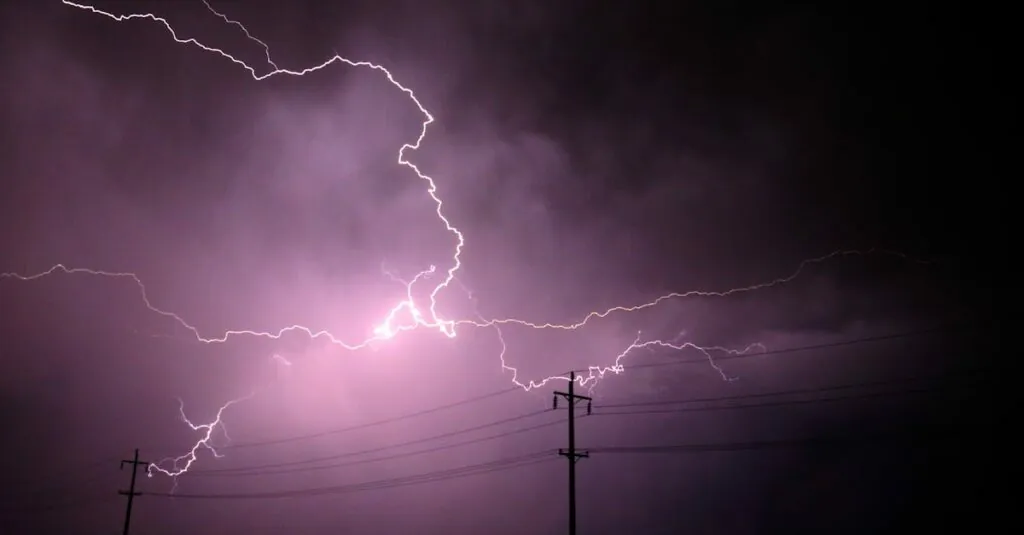Picture this: it’s pouring rain, and you’re standing by your electric vehicle, pondering the eternal question—should I plug it in or risk a shocking experience? Many electric vehicle owners share this concern, wondering if they’re about to create the world’s first electric puddle party. But fear not! Charging EVs in the rain isn’t just a wild idea; it’s a safe and common practice.
Table of Contents
ToggleUnderstanding Electric Vehicle Charging
Charging electric vehicles in various weather conditions, including rain, poses minimal risk due to advanced safety features. Understanding the mechanics of EV charging provides reassurance to owners.
Overview of Electric Vehicle Charging Mechanics
Electric vehicles use a combination of batteries, chargers, and electrical systems to manage energy transfer. During the charging process, electricity flows from a power source to the vehicle’s battery. Various connectors facilitate compatibility between chargers and charging ports, ensuring efficiency. Employing weather-resistant designs protects charging equipment from moisture. Many chargers come equipped with safety mechanisms that prevent electrical faults and overheating, further enhancing safety in adverse conditions. As such, users can confidently charge their EVs in the rain without worry.
Common Concerns Regarding Charging Safety
Concerns often arise regarding electrical shock or fire hazards when charging in wet weather. However, electric vehicle manufacturers adhere to stringent safety standards, minimizing these risks. Charging equipment includes insulation to prevent water intrusion, maintaining functionality and safety. The National Electric Code outlines rigorous guidelines for EV charging infrastructure, ensuring robust protection against moisture. Users often benefit from built-in safety features such as ground fault circuit interrupters, which automatically disconnect power when detecting anomalies. Addressing misconceptions about charging will reassure EV owners that charging in the rain remains safe.
Charging in Different Weather Conditions
Charging electric vehicles in various weather conditions ensures safety and reliability. Rain may raise concerns, yet both charging equipment and infrastructure are designed to withstand wet environments.
Impact of Rain on Charging Infrastructure
Rain doesn’t significantly impact charging infrastructure, as manufacturers prioritize durability. Equipment features weather-resistant materials that protect connections from moisture. Connection points often include seals that prevent water ingress. The National Electric Code supports regulations that ensure safety in all weather conditions. Charging stations undergo rigorous testing to confirm resilience against heavy rainfall. EV owners benefit from this protection, allowing them to charge without worry even during storms.
Safety Measures Implemented by Manufacturers
Manufacturers implement multiple safety measures in charging equipment to ensure safe use in wet conditions. Ground fault circuit interrupters offer an added layer of protection by automatically cutting power if a leak occurs. Insulation around electrical components prevents water from causing shock or short circuits. Charging cables are designed with robust coatings that minimize wear and tear, further enhancing safety. Compliance with safety standards helps guarantee that EV charging remains secure regardless of weather. Overall, these measures assure users that their EVs remain safe during rain.
Is It Safe to Charge EV in the Rain?
Charging electric vehicles in rainy conditions poses minimal risk due to robust safety measures in place. Electric vehicles and their charging stations are designed with advanced safety features that meet industry standards.
Industry Standards and Guidelines
Manufacturers follow strict safety regulations, ensuring that all components in EV charging stations are water-resistant. National Electric Code guidelines govern the installation and use of charging equipment, promoting safety during inclement weather. Ground fault circuit interrupters serve as an additional layer of protection against electrical shocks. These devices detect any faults in the electrical current and deactivate it, minimizing potential hazards. Many charging stations undergo rigorous testing to verify their reliability in adverse weather. This commitment to safety ensures that EV owners can charge confidently, regardless of conditions.
Real-Life Experiences and Case Studies
Numerous EV owners report charging their vehicles during rain without issues. Real-world case studies demonstrate the durability of charging stations throughout heavy storms. For instance, some stations in coastal areas withstand constant exposure to rain and saltwater, proving their resilience. Users often share positive experiences regarding the functionality of charging equipment, even during downpours. Maintenance teams inspect and maintain these stations regularly, further enhancing their reliability. Collectively, these experiences provide assurance that charging in rainy weather is safe and effective for electric vehicle owners.
Tips for Safe Charging During Rainy Conditions
Charging an electric vehicle during rainy weather is safe, but following certain tips enhances safety and convenience.
Recommended Charging Locations
Selecting the right charging location matters, especially in wet conditions. Look for charging stations that are well-maintained and covered, providing a barrier against rain. Choosing locations with good drainage also helps avoid puddles forming around the charging area. Stations near buildings or under canopies tend to be more reliable during storms. Many commercial charging stations are designed with the elements in mind, ensuring safety and usability in adverse weather.
Best Practices for EV Owners
Practicing safety while charging during rain is essential. Ensure the charging cable’s connectors are dry before starting the process. Inspect for any visible damage to cables or connectors, as compromised equipment poses risks. Unplugging the charger during heavy downpours prevents unnecessary exposure. Checking local weather updates aids in planning charging sessions, allowing users to avoid severe storms. Following these best practices minimizes risks and ensures efficient charging, even during rainy conditions.
Charging an electric vehicle in the rain is not only safe but also a common practice among EV owners. With advanced safety features and weather-resistant designs, manufacturers ensure that charging equipment remains reliable even in adverse conditions. The stringent standards set by the National Electric Code further bolster confidence in the safety of charging infrastructure.
Real-life experiences from EV owners demonstrate that charging during rainy weather poses minimal risk. By following simple tips such as choosing well-maintained charging stations and keeping connectors dry, drivers can enjoy the convenience of charging their vehicles without worry. Embracing these practices allows EV owners to charge confidently, regardless of the weather.




